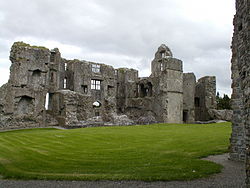Roscommon Castle
| Roscommon Castle | |
|
County Roscommon | |
|---|---|

| |
| Location | |
| Grid reference: | M87206494 |
| Location: | 53°38’3"N, 8°11’39"W |
| Town: | Roscommon |
| History | |
| Built 1269 | |
| Information | |
| Condition: | Ruins |
Roscommon Castle, now in ruins, stands on a hillside just outside Roscommon town, in County Roscommon. It was built in 1269 by Robert de Ufford, Justiciar of Ireland, on lands he had seized from the local Augustinian Priory.[1]
The castle is quadrangular in shape, it had four corner D-shaped towers, three storeys high, and twin towers at its entrance gateway, one of which still retains its immensely sturdy vaulted roof. The entire castle was enclosed by a lofty curtain wall.
History
Roscommon Castle has had a most chequered history. Robert de Ufford, Justiciar of Ireland, built it in 1269 on lands he had seized from the Augustinian Priory.[2] In 1272 it was besieged by Aodh Ó Conchobhair King of Connaught.
Eight years later Roscommon was again in the hands of an English garrison, and fully repaired. By 1340 the O'Connor's regained possession of it, and, except for a few brief intermissions, they held it for two centuries until 1569, when Sir Henry Sidney, Lord Deputy of Ireland, seized it.
In 1578 the castle was granted to Sir Nicholas Malbie, Queen Elizabeth's Governor of Connaught. Two years later the interior was remodeled and large mullioned windows were inserted in the towers and curtain walls. Again, in 1641 the Parliamentarian faction gained it until a force of the Irish Confederates commanded by Preston captured the castle in 1645.
The castle remained in Irish rebel hands until 1652 when it was partially blown up by Cromwellian "Ironsides" under Commissary Reynolds, who had all the fortifications dismantled. It was finally burned down in 1690, and, from the closing years of the 17th-century, it gradually fell into decay. A symmetrical moat some distance from the curtain walls surrounded the entire castle and safeguarded it. It is now a national monument.[3]